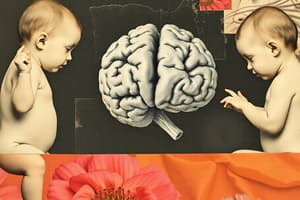Podcast
Questions and Answers
What significant development occurs in infants' brains as they mature?
What significant development occurs in infants' brains as they mature?
- Axons grow in length and dendrites multiply (correct)
- Neurons decrease in number
- Myelination stops by age 2
- Synaptic connections do not change
What should infants be consuming when they reach 12 months of age?
What should infants be consuming when they reach 12 months of age?
- Whole cow's milk (correct)
- Breast milk
- Fruit juice
- Solid foods
Which statement best describes the influence of nature and nurture on motor development?
Which statement best describes the influence of nature and nurture on motor development?
- Motor development is solely influenced by nurture
- Motor development is unaffected by environmental factors
- Both maturation and experience are necessary for motor development (correct)
- Motor development is solely influenced by nature
What is the first motor skill typically achieved by infants?
What is the first motor skill typically achieved by infants?
How do infants respond to familiar odors according to their sensory development?
How do infants respond to familiar odors according to their sensory development?
Which aspect of cognitive development begins in utero for infants?
Which aspect of cognitive development begins in utero for infants?
What could be a negative influence on a parent's decision to breastfeed?
What could be a negative influence on a parent's decision to breastfeed?
At what age do infants typically start to stand alone well?
At what age do infants typically start to stand alone well?
At what age do infants begin to show nearsightedness and prefer faces?
At what age do infants begin to show nearsightedness and prefer faces?
What does assimilation refer to in Piaget's theory?
What does assimilation refer to in Piaget's theory?
Which of the following describes the 'primary circular reactions' stage of Piaget's first stage of development?
Which of the following describes the 'primary circular reactions' stage of Piaget's first stage of development?
What characterizes the tertiary circular reactions in Piaget's stages?
What characterizes the tertiary circular reactions in Piaget's stages?
At what age do infants typically begin to crawl, which contributes to their depth perception?
At what age do infants typically begin to crawl, which contributes to their depth perception?
Which statement best reflects a concern about Piaget's theory?
Which statement best reflects a concern about Piaget's theory?
What developmental change occurs in language from birth to age 3 months?
What developmental change occurs in language from birth to age 3 months?
What role do schemes play in Piaget's cognitive development theory?
What role do schemes play in Piaget's cognitive development theory?
What does the Interactionist Perspective suggest about the origins of language?
What does the Interactionist Perspective suggest about the origins of language?
Who conducted studies on attachment that highlighted the importance of comfort in addition to nourishment?
Who conducted studies on attachment that highlighted the importance of comfort in addition to nourishment?
What is the primary emotional reaction associated with secure attachment in young children?
What is the primary emotional reaction associated with secure attachment in young children?
What does Erikson define as the central challenge during the first stage of human development?
What does Erikson define as the central challenge during the first stage of human development?
Which type of attachment is characterized by conflicting behaviors and high distress when the caregiver leaves?
Which type of attachment is characterized by conflicting behaviors and high distress when the caregiver leaves?
According to Izard's theory of emotion, how many primary emotions are identified?
According to Izard's theory of emotion, how many primary emotions are identified?
What is meant by a 'sensitive period' for attachment?
What is meant by a 'sensitive period' for attachment?
What is the main focus of the Learning Theory as proposed by Skinner regarding language acquisition?
What is the main focus of the Learning Theory as proposed by Skinner regarding language acquisition?
Flashcards are hidden until you start studying
Study Notes
Brain and Nervous System Development
- Infants are born with all the neurons they will ever have.
- Brain development occurs due to both nature and nurture.
- Nature: Maturation, myelination and differentiation.
- Nurture: Sensory stimulation and motor activity.
- As a child matures:
- Axons grow in length.
- Dendrites and axon terminals multiply, creating more complex networks.
- Myelination occurs around axons, allowing impulses to transmit quickly. This process continues until around age 25.
Motor Development
- Motor development changes significantly from birth to age 2, encompassing both gross and fine motor skills.
- Examples of motor development milestones:
- 3.2 months: Rolling over
- 3.3 months: Grasping a rattle.
- 5.9 months: Sitting without support.
- 7.2 months: Standing while holding on.
- 8.2 months: Grasping with thumb and finger.
- 11.5 months: Standing alone well.
- 12.3 months: Walking well.
- 14.8 months: Building a tower of 2 cubes.
- 16.6 months: Walking up steps.
- 23.8 months: Jumping in place.
- Motor development is influenced by both nature and nurture.
- Nature: Maturation (myelination and differentiation), motivation.
- Nurture: Experience (experimentation, training).
Growth and Nutrition
- Newborns should be fed breast milk or formula.
- Solid foods should be introduced around 6 months of age.
- Whole cow's milk can be introduced at 12 months.
- Breastfeeding has pros and cons:
- Pros: Benefits for both mother and child.
- Cons: Can be influenced by factors like health, attitudes about bonding, fear of pain, work arrangements, and social support.
Cognitive Development
- Infants develop cognitive abilities from birth to age 3.
- Sensory development:
- Hearing: Begins in utero and infants recognize their mother's voice at birth.
- Smell: Well developed at birth; infants recognize familiar odors.
- Taste: Sensitive to different tastes and prefer sweet because of breastmilk.
- Touch: Enjoy being cuddled, rocked, and stroked.
- Visual: Nearsighted early on, infants prefer faces.
- Convergence: Not until 7 or 8 weeks.
- Depth: Develops with crawling at 6 months.
- Perceptual: Develops around 4 months.
Piaget's Cognitive Development Theory
- Piaget believed that cognitive development occurs through specific stages.
- His theory focuses on schemes, assimilation, and accommodation:
- Schemes: Concepts or ways to organize knowledge.
- Assimilation: Fitting new ideas into existing schemes.
- Accommodation: Modifying schemes to accept new ideas.
- Piaget's 1st Stage of Development (Sensorimotor Period):
- Substage 1: Birth - 1 month (simple reflexes).
- Infants' responses are based on reflexes.
- Examples: Sucking, grasping, modifying reflexes based on experience.
- Substage 2: 1 - 4 months (primary circular reactions).
- Focus on infants' own body.
- Circular: Repeated behaviors.
- Substage 3: 4 - 8 months (secondary circular reactions).
- Focus on objects or events.
- Substage 4: 8 - 12 months (coordination of secondary schemes),
- Coordinate schemes to attain specific goals.
- Beginning of intentionality.
- Substage 5: 12 - 18 months (tertiary circular reactions).
- Deliberate trial and error behaviors.
- "Little scientist" stage.
- Substage 6: 18 - 24 months (beginning of thought).
- Mental exploration.
- Begin to think before doing.
- Deferred imitation.
- Substage 1: Birth - 1 month (simple reflexes).
- Piaget's theory has pros and cons:
- Pros: Comprehensive, research-supported, sequence appears cross-culturally.
- Cons: Stages may be more gradual than discontinuous, may underestimate infants' competence, generalizability.
Language Development
- Language develops from birth to age 3.
- Milestones:
- Birth: Perceives speech, cries, responds to sound.
- 1 ½ - 2 years: Coos and laughs.
- 3 years: Plays with speech sounds.
- Language development is influenced by both nature and nurture.
- Nativism (Chomsky): The human brain is inherently designed for language.
- Learning Theory (Skinner): Operant conditioning; parents reinforce sounds made by children.
Attachment
- Attachment is an emotional bond or trust between individuals.
- There's not a critical period, but a sensitive period for attachment during the first six months of life.
- Harlow's research showed that attachment is not only based on food provision but also on comfort and close bodily contact.
- Types of Attachment:
- Secure: Explores with mother, distressed when she leaves, happy she returns.
- Insecure-Avoidant: Explores without mother, little distress when she leaves, avoids her upon return.
- Insecure-Ambivalent: Clings to mother, high distress when she leaves, ambivalent upon her return.
- Insecure-Disorganized: Confused, little distress when mother leaves, confused upon her return.
- Attachment style is influenced by both biological and environmental factors.
Erikson's Stages of Psychosocial Development
- Erikson's first two stages describe personality development in infancy.
- Trust vs. Mistrust: (Birth - 1 year) Develops trust in people and their surroundings.
- Autonomy vs. Shame and Doubt: (1 - 3 years) Develops independence and self-sufficiency.
Emotions
- Emotions have basic components such as facial expressions, physiological arousal, and subjective feelings.
- Theories about the origin of emotions:
- Biologically Based Theories:
- Temperament: Early-appearing biologically based tendency to respond to the environment in predictable ways.
- Ekman: Emotional expressions are similar across cultures, suggesting a genetic basis.
- Izard: Theory of emotion identified ten primary and discrete emotions (fear, anger, shame, contempt, disgust, guilt, distress, interest, surprise, and joy).
- Cognitive-Socialization Theories:
- Children learn to process information and make meaning from their experiences.
- Emotional development is influenced by the environment.
- Complex emotions unfold from simpler ones.
- Biologically Based Theories:
Studying That Suits You
Use AI to generate personalized quizzes and flashcards to suit your learning preferences.




